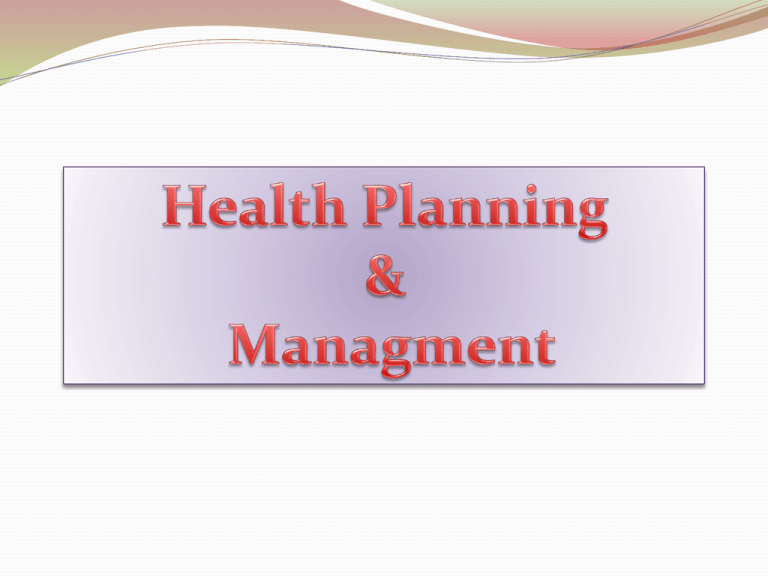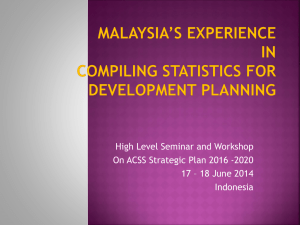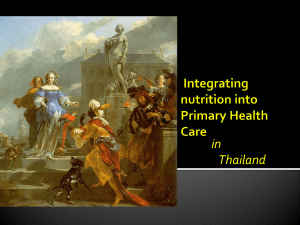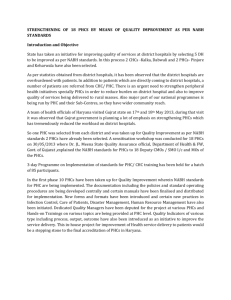
Planning:
To match the limited resources with many
problems.
To eliminate wasteful expenditure or duplication
of expenditure.
To develop the best course of action to accomplish
a defined objective.
Planning includes three steps :
Plan formulation
Execution
Evaluation
Development Planning:
Continuous ,systematic, coordinated, planning
for the investment of the resources of a country
in programmes aimed at most rapid economic
and social development possible.
Health Planning:
The orderly process of defining community health
problems , identifying unmet needs and surveying
the resources to meet them, establishing priority
goals that are realistic and feasible and projecting
administrative action to accomplish the purpose of
the proposed programme.
Resources:
Implies the manpower , money , materials, skills
knowledge , techniques and time needed or
available for the performance or support of
action directed towards specified objectives.
Objective : It is precise , concerned directly with
the problem. Planned end point of all activities
Target : It permits concept of degree of
achievement ; concerned with factors involved in a
problem.
Goal : The ultimate desired state towards which
objectives and resources are directed.
Plan :
Blue print for taking action
It has five major elements:
Objectives, policies, programmes, schedule &
budget
Policies : Guiding principles stated as an
expectation , not as a commandment.
Programmes : Sequence of activities designed to
implement policies and accomplish objectives.
Schedule : Time sequence for the work to be
done.
Procedures : Set of rules for carrying out work
which , when observed by all help to ensure the
maximum use of the resources and efforts.
Pre –planning:
Preparation for planning.
Important preconditions are:
• Government interest
• Legislation
• Organization for planning – Planning
commission of India
• Administrative capacity – Central & State
Ministries of Health
PLANNING CYCLE:
Defined as a process of analyzing a system or
defining a problem, assessing the extent to which the
problem exist as a need , formulating goals and
objectives to alleviate or ameliorate those identified
needs , examining and choosing from among
alternative intervention strategies , initiating the
necessary action for its implementation of the plan and
evaluating the results of intervention in the light of
stated objectives.
Steps:
1.
Analysis of health situation: involves the
collection , assessment and interpretation of
information in such a way as to provide a
clear picture of the health situation.
2. Establishment of objectives and goals
3. Assessment of resources
4. Fixing priorities
5. Write up of formulated plan
6. Programming and implementation
7. Monitoring
8. Evaluation
MANAGEMENT
purposeful and effective use of resources –
manpower , materials and finances – for fulfilling a
pre-determined objective.
Consists of four basic activities:
Planning
Organizing
Communicating
Monitoring
Management methods and techniques
Based on behavioral sciences
1. Organizational design
2.Personnel management
3.Communication
4.Information Systems
5.Management by objectives
Quantitative methods
1.Cost Benefit Analysis
2.Cost Effective Analysis
3.Cost Accounting
4.Input Output Analysis
5.Model
6.System Analysis
7.Network Analysis
8.PPBS
9.Work Sampling
10.Decision Making
1) Cost –Benefit Analysis:
Economic benefits of any programme are
compared with cost of that programme.
Benefits are expressed in monetary terms to
determine whether a given programme is
economically sound and to select best out of several
alternate programmes.
2) Cost –Effective Analysis:
Similar to cost benefit analysis except that benefit
instead of being expressed in monetary terms is
expressed in terms of results achieved.
3) Cost Accounting:
Provides basic data on cost structure of any
programme.
Has 3 important purpose in health services: Cost
control , planning and allocation of people & pricing of
cost reimbursement.
4) Input –Output Analysis:
Input refers to all health service activities which
consume resources.
Output refers to such useful outcomes as cases treated
and lives saved.
An input –output table shows how much of each
input is needed to produce a unit amount of each output.
Enables calculations to be made of the effects of
changing the inputs.
5) Model:
An aid to understand how the factors in a situation
affect one another.
Is an abstraction of the reality.
6) Systems Analysis:
To help the decision maker to choose an appropriate
course of action by investigating his problem, searching
out objectives, finding out alternative solutions, evaluation
of alternatives in terms ,re-examination of objectives if
necessary & finding the most cost effective alternative.
7) Network Analysis:
Network is a graphic plan of all events and activities
to be completed in order to reach an end objective.
Two common types of network technique:
PERT(Programme Evaluation and Review
Technique)
CPM ( Critical Path Method)
PERT(Programme Evaluation and Review Technique):
Technique which makes possible more detailed
planning & more comprehensive supervision
Essence of PERT is to construct an Arrow diagram,
which represents the logical sequence in which events
must take place
Time taken to complete each activity can be calculated
Can identify paths which are critical
CPM ( Critical Path Method):
It the longest path of the network
If any activity along the critical path is delayed, the
entire project will be delayed
2 months
Staff
recruited
Staff
Trained
4 months
S
T
A
R
T
Plan
Service
1 month
2 months
Equipment
ordered
Equipment
installed
10 months
1 month
Start
providing
Service
TERMINAL
EVENT
8) Planning Programming Budgeting System(PPBS):
A system to help decision makers to allocate resources
so that the available resources of an organization are used
in the most effective way in achieving its objectives.
It calls for grouping of activities into programmes
related to each objective.
Another approach is Zero Budget Approach i.e all
budget starts at zero & no one gets any budget that he
cannot specifically justify on a year to year basis
9)Work Sampling:
Is a systematic observation and recording of
activities of one or more individuals, carried out at
predetermined or random intervals
It provides quantitative measurement of the
various activities.
It helps in standardizing the method of
performing jobs and determining the manpower
needs in any organization.
10) Decision Making:
It does not follow that the best decisions are always
made at the top of an organization
An adage that decisions should be made at the level
where the best decisions can be made
Decisions should not be made with incomplete
data.
Health planning in India
Integral part of national socio economic planning
Government of India appoints different committees
from time to time to review existing health situations
and recommend measures for further actions
Hence guidelines for national health planning were
provided by number of committees
Bhore committee,1946
‘Health survey & development committee’
Integration of preventive & curative services at all
administrative levels
PHC cater to 40,000 population with a 2* health centre
to serve as supervisory, coordinating & referral
institution
3 million plan3 months training in PSM to prepare “social
physicians”
Mudaliar committee,1962
‘Health survey and planning committee’
Strengthening of existing PHCs before new centers
were established
Strengthening of District hospitals with specialist
services
Each PHCs not to serve more than 40000 population
Consolidations of advances made in first two five year
plans
Constitution of an All India Health Service on the
pattern of Indian Administrative service
Chadah committee, 1963
National malaria eradication programme
responsibility of general health services, i.e., PHC at
block level
Monthly home visits by basic health worker for
vigilance operations of Malaria
One basic health worker/ 10000 population
Basic health worker also called multipurpose worker,
entrusted to look after duties like vital statistics, family
planning etc
Mukherji committee, 1965 & 1966
1965:
Delinked malaria and family planning programmes
Separate staffs for both programmes
1966:
Worked out Basic Health Service which should be
provided at block level
Jungalwalla committee, 1967
‘Committee on Integration of Health Services’
Integration from the highest to the lowest level in the
services, organization & personnel
Unified cadre
Common seniority
Recognition of extra qualifications
Equal pay for equal work
Special pay for specialized work
No private practice
Kartar Singh committee, 1973
‘The committee on Multipurpose Workers under Health &
Family Planning’
ANM to be replaced by ‘Female Health Worker’ & Basic
health workers, Malaria surveillance workers, vaccinators
etc to be replaced by ‘Male Health Worker’
One PHC for 50000 population
Each PHC should be divided into 16 sub centers which
caters to 3000 – 3500 population
Each sub centre to be staffed by a team of one male and one
female health worker
Doctors in charge of PHC should have overall charge of all
supervisors and health workers in his area
Shrivastav committee, 1975
‘Group on Medical Education & Support Manpower’
Creation of bands of Para & semi professional health
workers from within the community itself
Development of a ‘Referral Services Complex’
Establishment of a Medical & Health Education
Commission for planning & implementing the reforms
needed in health & medical education
Recommends one male & female health worker for 5000
population
Health assistant should be located at the sub centre, not at
the PHC
Rural Health Scheme, 1977
Steps were initiated for involvement of medical
colleges in the total health care of selected PHCs with
the objective of reorienting medical education to the
needs of rural people
Reorienting training of MPWs engaged in the control
of various communicable disease programmes into
Unipurpose workers
Health for all by 2000 AD
Report of working group, 1981
National Health Policy - 2002
Eradicate Polio & Yaws
- 2005
Eliminate leprosy
- 2005
Eliminate Kala- Azar
- 2010
Eliminate Lymphatic Filariasis
- 2015
Achieve zero level growth of HIV/AIDS
- 2007
Reduce mortality by 50% on account of TB,
Malaria & other vector & water borne disease - 2010
Reduce the prevalence of blindness to 0.5%
- 2010
Reduce IMR to 30/1000 & MMR to 100/ Lakh - 2010
Increase state sector health spending from 5.5%
to 7 & of the budget
- 2005
Eleventh Five Year Plan (2007-2012)
Reducing MMR to 1 per 1000 live births
Reducing IMR to 28 per 1000 live births
Reducing TFR to 2.1
Providing clean drinking water for all by 2009
Reducing malnourishment among children of age
group 0-3 to half its present level
Reducing anemia among women & girls by 50%
Raising the sex ratio for age group 0-6 years to 935 by
2011-12 & 950 by 2016-17
Twelfth Five Year Plan (2012-2017)
Health System In India
Central Level:
1. Union Ministry of Health & Family Welfare
2. Directorate General of Health Services
3. Central Council of Health
State Level:
1. State Ministry of Health
2. State Health Directorate
Health System In India contd..
District Level:
The Collector
Administrative areas under district:
I. Sub divisions
II. Tahsils (Talukas)
III. Community Development Blocks
IV. Municipalities & corporations
V. Villages
VI. Panchayats
PANCHAYATI RAJ:
Three tier structure of rural local self government in India
All developmental programmes are channeled through
these bodies
Links the village to the district
The three institutions are
1. Panchayat – at village level
2. Panchayat Samiti – at block level
3. Zilla parishad – at district level
Evaluation of Health Services
General steps of evaluation:
1. Determine what is to be evaluated
2. Establish standards and criteria
3. Plan the methodology to be applied
4. Gather information
5. Analyze the results
6. Take action
7. Re-evaluate






